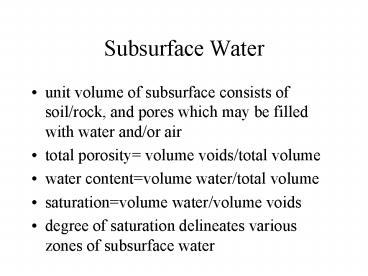Subsurface Water
1 / 12
Title: Subsurface Water
1
Subsurface Water
- unit volume of subsurface consists of soil/rock,
and pores which may be filled with water and/or
air - total porosity volume voids/total volume
- water contentvolume water/total volume
- saturationvolume water/volume voids
- degree of saturation delineates various zones of
subsurface water
2
Definitions
- soil water - Ground surface to bottom of root
zone depth depends on soil type and vegetation.
May become saturated during periods of rainfall
otherwise unsaturated (soil pores partially
filled with air). Plants extract water from this
zone. Evaporation occurs from this zone. - intermediate vadose zone - Between soil water
zone and capillary fringe. Unsaturated except
during extreme precipitation events. Depth of
zone may range from centimeters to 100s of
meters.
3
Definitions Continued
- capillary zone - Above saturated zone. Water
rises into this zone as a result of capillary
force. Depth of this zone is a function of the
soil type. Fractions of a meter for sands (mm)
to meters for fine clays. All pores filled with
H2O, p lt 0. Effect seen if place bottom of dry
porous media (soil or sponge) into water. Water
will be drawn up into media to a height above
water where soil suction and gravity forces are
equal. - saturated zone - All pores filled with water, p gt
0. Formations in this zone with ability to
transmit water are called aquifers.
4
Unsaturated Zone
- Water can exist in all its phases in the
unsaturated zone. - Liquid water occurs as
- hygroscopic water - adsorbed from air by
molecular interaction (H-bonds) - capillary water - held by surface tension due to
viscosity of liquid - gravitational water-water in unsaturated zone in
excess of field capacity which percolates
downward due to gravity ultimately reaching
saturated zone as recharge.
5
Unsaturated Zone
- Hygroscopic and capillary waters are held by
molecular electrostatic forces (between polar
bonds and particles -- surface tension) in thin
films around soil particles ? drier soil, smaller
pores ? hygroscopic and capillary forces - Hygroscopic water - held at -31 to -10,000 bars.
Water is unavailable to plants or for recharge to
groundwater. - Capillary water - Held at -0.33 to -31 bars.
More water filling pores but discontinuous except
in capillary fringe. This water can be used by
plants.
6
Definitions
- Permanent wilting point tension (suction,
negative pressure) below which plant root system
cannot extract water. Depends on soil and type
of vegetation. Typically -15 bars (-15x105 Pa,
-15000cm - Field capacity tension (suction, negative
pressure) below which water cannot be drained by
gravity (due to capillary and hygroscopic forces)
Depends on soil type. Typically about -0.33
bars
7
Typical Moisture Profiles
- rain after a long dry period
moisture content
root zone
direction of moisture movement
depth
wilting point
field capacity
hygroscopic
saturation
8
Typical Moisture Profiles
- Drying process
moisture
1 - Drying in upper layers by ET. 2 - Bottom part
of wetting front continues ?. Upper part
continues to dry. 3 - At some point ? and ?
movement results in no moisture gradient 4 -
Dry front established. Lower zones are
being depleted to satisfy PET at surface.
Drying continues until capillary forces are
unable to move water to surface.
depth
field capacity
saturation
9
Dacry-Buckingham law
- Flow in unsaturated porous media governed by a
modified Darcys law called Darcy-Buckingham law
- ? - suction head (capillary head) or negative
pressure head. Energy possessed by the fluid due
to soil suction forces. Suction head varies with
moisture content, ? ? n, ?? 0, ? lt n , ? is
negative. - K(?) - hydraulic conductivity is a function of
water content ? ?,? K(?) because more
continuously connected pores, more space
available for water to travel through, until at
? n, K(n) Ksat
10
Measuring Soil Suction
- Soil Suction (?) head measured with tensiometers,
an airtight ceramic cup and tube containing
water. - Soil tension measured as vacuum in tubes created
when water drawn out of tube into soil. Comes to
equilibrium at soil tension value. - Tensiometers often used to schedule irrigation.
11
Estimating water flux from tensiometer
measurements
h z ? h1 100 cm - 65 cm 35 cm h2 50 cm
- 50 cm 0 cm
h1 z1 ?1
?1 (negative) (-65 cm)
z1 100 cm
h2 z2 ?2
?2 (negative) (-50 cm)
z2 50 cm
z 0
12
- Look at components of flux
- Capillary gradient cause upward flow,
gravitational gradient causes downward flow. Net
flux is down. - What would it take to get net flux upward?































